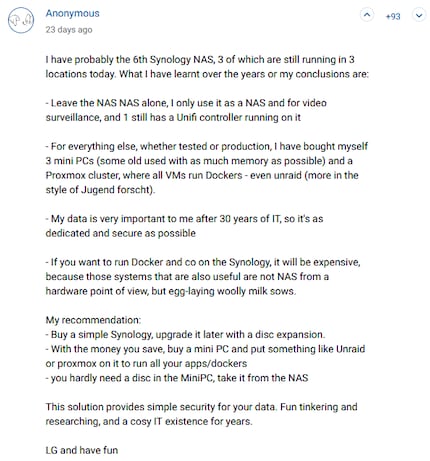
Background information
My own NAS system – Part 1: a hard farewell to Synology
by Richard Müller

My Synology NAS is getting on in years. Although I’m happy with it, I want to switch to a new operating system. But the Community has objections, some of which are justified. This is part two of a series in search of the right network storage solution.
The first article in my series generated tonnes of feedback from the community. From thanks and tips to questions, e-mails, constructive input and criticism.
I’d expected reactions, but not so many. To understand what comes next, it’s really worth reading the first article in my series. I decided to leave the safe haven of Synology and build my own NAS.
The main points of criticism and tips can be summarised as follows:
Some analysed the photo of my Synology DS916+ on the shelf and pointed things out (automated English translation):

Many readers think there’s enough room for a smaller NAS than the one I have in mind. «Richie, think it over,» starts swirling around my head. If this many users agree, there has to be a kernel of truth to it.
I measure out the NAS spot again and realise the Community’s criticism is justified. Only Synology models with a maximum of six hard disk bays will fit on the shelf.
Then why did I only compare models with twelve bays? Well, the shelf which houses my DS916+ is made to measure. Due to little alternative space available in the living room, it’s the only location that works. Pre-fab furniture was and isn’t an option because of the sound system I bought.
However, it turns out the finished shelf offers more space than the manual says. I must’ve overlooked that. After all, more than a year has passed between my shelf project and the writing of this article. I’m sure this’ll lead to jeers and cheeky comments, but no matter, I’ll take it in my stride! After all, anyone who makes a mistake has to face the music.

What’s more, I didn’t take into account that I could move the old hard disks from the DS916+ to a new NAS. This’d save me money when buying a replacement. I should’ve thought of it, as I did exactly that when switching from my first Synology to the DS916+.

I therefore include the hard disks in my calculation for a replacement NAS. You suggested the following Synology models:
I’ve deliberately listed models without hard disks. I still have to ponder the optimal hard disk size for my situation. Regarding size, you repeatedly suggested 12-terabyte hard disks:
Assuming four hard disks, the cost of a replacement NAS is between 1,811 and 2,100 francs, depending on the model. That’s significantly less than what I got the first time. I arrived at 4,700 francs for a Synology with twelve hard disk bays.
I’m going to buy one of the Synology models the Community suggested, just not sure which one yet. One thing is clear: I’ll migrate the hard disks first, then replace them step by step at a later date. This way I’ll have hard disks from different production batches, reducing the risk that, in a worst-case scenario, they’re all defective at the same time.
However, I’m also sticking to my plan of building my own NAS. Why? Because I want to. I’ll set up applications, virtual machines and Docker containers on it. This home-made network storage unit will be my playground.
I’ll store my family and work data on the new Synology. This way I’ll be certain they’re safe on a stable system.
If something should ever malfunction on my home-built NAS, I won’t have to worry about the security of the data stored there. Sure, plenty of maintenance still needs doing. However, I can take care of it without any time pressure. If I ever switch completely to my home-built NAS at a later date, I’ll be able to better assess new issues.

My «old» Synology’s getting a second life – in my workshop, not my flat. I’ll use it to back up all my data.
In the next article, I’ll take a look at various NAS operating systems for DIY NAS projects. The aim is selecting a system that’s user-friendly, offers many options, but doesn’t require an immense amount of effort to operate. After that, I’ll deal with hardware, installing the operating system and setting up the server. I’m looking forward to this journey as well as your input.
Header image: David Lee
I'm a journalist with over 20 years of experience in various positions, mostly in online journalism. The tool I rely on for my work? A laptop – preferably connected to the Internet. In fact, I also enjoy taking apart laptops and PCs, repairing and refitting them. Why? Because it's fun!
Interesting facts about products, behind-the-scenes looks at manufacturers and deep-dives on interesting people.
Show all